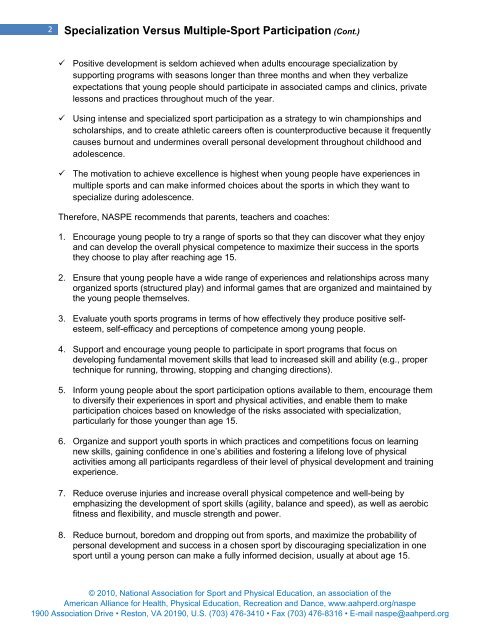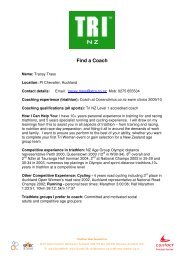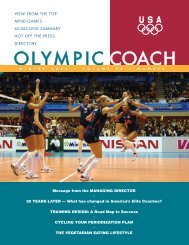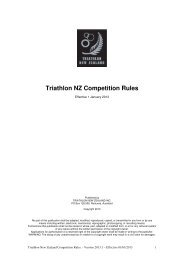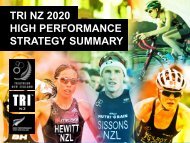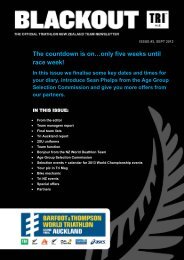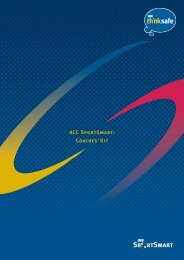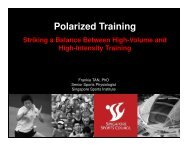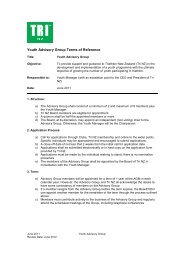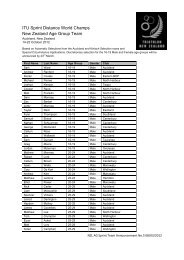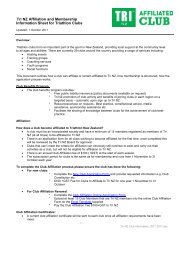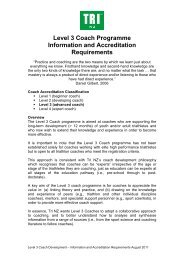Guidelines for Participation in Youth Sport Programs ... - AAHPERD
Guidelines for Participation in Youth Sport Programs ... - AAHPERD
Guidelines for Participation in Youth Sport Programs ... - AAHPERD
Create successful ePaper yourself
Turn your PDF publications into a flip-book with our unique Google optimized e-Paper software.
2 Specialization Versus Multiple-<strong>Sport</strong> <strong>Participation</strong> (Cont.) Positive development is seldom achieved when adults encourage specialization bysupport<strong>in</strong>g programs with seasons longer than three months and when they verbalizeexpectations that young people should participate <strong>in</strong> associated camps and cl<strong>in</strong>ics, privatelessons and practices throughout much of the year. Us<strong>in</strong>g <strong>in</strong>tense and specialized sport participation as a strategy to w<strong>in</strong> championships andscholarships, and to create athletic careers often is counterproductive because it frequentlycauses burnout and underm<strong>in</strong>es overall personal development throughout childhood andadolescence. The motivation to achieve excellence is highest when young people have experiences <strong>in</strong>multiple sports and can make <strong>in</strong><strong>for</strong>med choices about the sports <strong>in</strong> which they want tospecialize dur<strong>in</strong>g adolescence.There<strong>for</strong>e, NASPE recommends that parents, teachers and coaches:1. Encourage young people to try a range of sports so that they can discover what they enjoyand can develop the overall physical competence to maximize their success <strong>in</strong> the sportsthey choose to play after reach<strong>in</strong>g age 15.2. Ensure that young people have a wide range of experiences and relationships across manyorganized sports (structured play) and <strong>in</strong><strong>for</strong>mal games that are organized and ma<strong>in</strong>ta<strong>in</strong>ed bythe young people themselves.3. Evaluate youth sports programs <strong>in</strong> terms of how effectively they produce positive selfesteem,self-efficacy and perceptions of competence among young people.4. Support and encourage young people to participate <strong>in</strong> sport programs that focus ondevelop<strong>in</strong>g fundamental movement skills that lead to <strong>in</strong>creased skill and ability (e.g., propertechnique <strong>for</strong> runn<strong>in</strong>g, throw<strong>in</strong>g, stopp<strong>in</strong>g and chang<strong>in</strong>g directions).5. In<strong>for</strong>m young people about the sport participation options available to them, encourage themto diversify their experiences <strong>in</strong> sport and physical activities, and enable them to makeparticipation choices based on knowledge of the risks associated with specialization,particularly <strong>for</strong> those younger than age 15.6. Organize and support youth sports <strong>in</strong> which practices and competitions focus on learn<strong>in</strong>gnew skills, ga<strong>in</strong><strong>in</strong>g confidence <strong>in</strong> one’s abilities and foster<strong>in</strong>g a lifelong love of physicalactivities among all participants regardless of their level of physical development and tra<strong>in</strong><strong>in</strong>gexperience.7. Reduce overuse <strong>in</strong>juries and <strong>in</strong>crease overall physical competence and well-be<strong>in</strong>g byemphasiz<strong>in</strong>g the development of sport skills (agility, balance and speed), as well as aerobicfitness and flexibility, and muscle strength and power.8. Reduce burnout, boredom and dropp<strong>in</strong>g out from sports, and maximize the probability ofpersonal development and success <strong>in</strong> a chosen sport by discourag<strong>in</strong>g specialization <strong>in</strong> onesport until a young person can make a fully <strong>in</strong><strong>for</strong>med decision, usually at about age 15.© 2010, National Association <strong>for</strong> <strong>Sport</strong> and Physical Education, an association of theAmerican Alliance <strong>for</strong> Health, Physical Education, Recreation and Dance, www.aahperd.org/naspe1900 Association Drive • Reston, VA 20190, U.S. (703) 476-3410 • Fax (703) 476-8316 • E-mail naspe@aahperd.org


